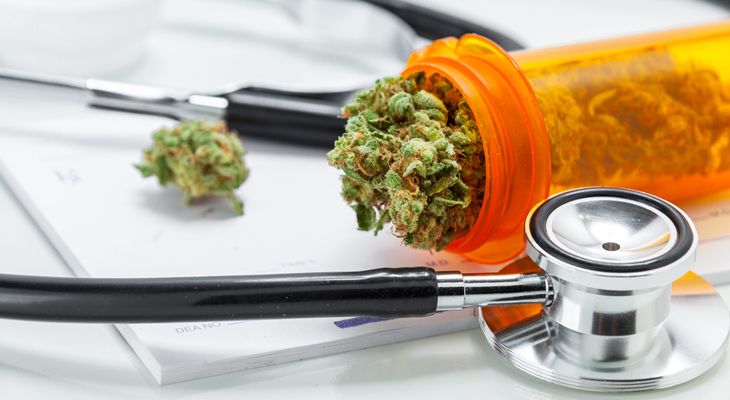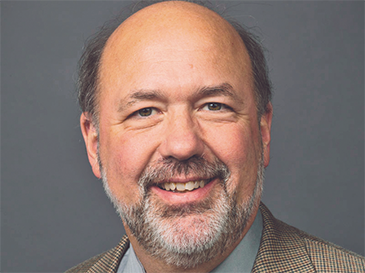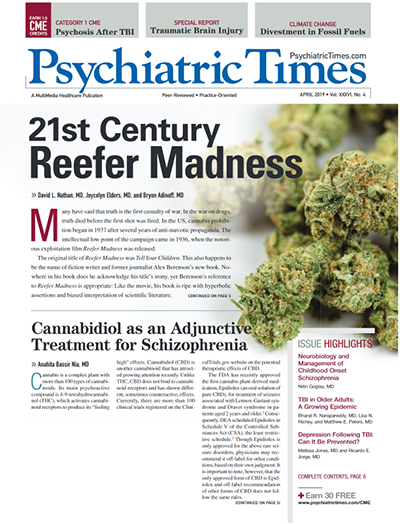Publication
Article
Psychiatric Times
Is It Time to Legalize Cannabis?
Author(s):
The controversial question of whether to legalize cannabis has emerged front and center as an important issue that deserves a serious and thoughtful dialogue.
©BestStockPhoto/Shutterstock


From the Editor
The controversial question of whether to legalize cannabis has emerged front and center as an important issue that deserves a serious and thoughtful dialogue. Cannabis is the general term for substances derived from the plant Cannabis sativa, with varying psychoactive and pharmacological properties that are found in 3 organic products: marijuana, hemp, and cannabinoids. With each passing year more states legalize cannabis-currently 10 states-and a much larger number of states pass legislations to decriminalize cannabis, make it legal for medical use, or both.
This creates increasing confusion across the country, as the legal ramifications of possessing and using cannabis in each state becomes increasingly complex. Thoughtful arguments can be made supporting or decrying the legalization of cannabis based on an array of issues: medical risks and benefits, psychiatric risks and benefits, the possibility of easier access by vulnerable populations, legal consequences, strong-held cultural beliefs, political ideologies, potential for tax revenue, and the fostering of outdated myths about cannabis.
In this month’s issue, Former Surgeon General Joycelyn Elders and colleagues make yet another compelling argument for the legalization of cannabis. Having cannabis classified as a Schedule 1 drug (classifying cannabis as illegal, with no clinical benefits) has stymied research into this complex portfolio of over 100 cannabinoid molecules-the 2 most common being delta-9-tetrahydrocannabinol (THC) and cannabidiol (CBD). Since cannabis is illegal under federal law, researchers face significant restrictions and regulation. As a result, research has been slow, and the endogenous presence of a cannabinoid receptor in the human brain was not confirmed until 1990.
FDA approval of cannabidiol
Significantly, in June 2018 the FDA approved one of the primary components of cannabis, CBD (brand name Epidiolex), for the treatment of seizures in Dravet syndrome and Lennox-Gastaut syndrome in children and adults. As a result of this FDA approval, the Drug Enforcement Administration reclassified CBD from a Schedule 1 drug (illegal), to a Schedule 5 “controlled substance” (in the same class as pregabalin).
A rapidly growing body of double-blind placebo-controlled studies are demonstrating clinically effective properties of CBD. It is not euphorogenic and demonstrates clinical effects that are opposite to THC. CBD has demonstrated anti- inflammatory and antioxidant effects, and findings suggest benefits of its treatment for seizures, psychosis, anxiety, multiple sclerosis, and movement disorders.
The extensive amount of information now available on cannabis is exemplified by the 2017 publication The Health Effects of Cannabis and Cannabinoids: The Current State of Evidence and Recommendations for Research.1 All relevant publications on cannabis were reviewed for this document and the document nicely describes the degree of evidence supporting the risks and benefits of cannabis use. The following possible or established benefits are listed: anti-emetic effect in chemotherapy-induced nausea/vomiting; increased appetite and decreased weight loss in individuals with HIV/AIDS; improved clinician-measured and patient-reported spasticity in multiple sclerosis; improved short-term sleep in individuals with a documented sleep disturbance; improved symptoms in some anxiety disorders; decrease in some types of chronic pain in adults; and improved symptoms in Tourette syndrome.
Neurobiology of cannabis
After discovering the cannabinoid receptor in 1990, a plethora of basic science studies has taught us a great deal about the neuropharmacology of the two most active ingredients in cannabis-THC and CBD-which are pharmacologically complementary. In the early 1960s, when cannabis was widely used by our country’s youth, the leaves from the marijuana plant were derived from the original naturally occurring plants that had been harvested since approximately 3000 BC-Cannabis sativa.
In the original cannabis plant, the THC content was roughly 2%, with relatively equal amounts of CBD. Once THC was identified as the cannabinoid associated with the “high,” marijuana plant breeders genetically enriched subsequent generations of plants to have increased THC-up to 30%-and decreased CBD. The most potent form of THC is called “wax,” which is 50% pure THC. A 2016 article documented that the ratio of THC to CBD of illegally sold cannabis in the US increased from 14:1 to 80:1 between 1995 and 2014.2
Following the discovery of the first endogenous cannabinoid receptor in 1990, a second receptor was found: aptly named cannabinoid 1 receptor (CB1R) and cannabinoid 2 receptor (CB2R). CB1R is the primary receptor in the mammalian brain and is present in high concentrations in the hippocampus, hypothalamus, amygdala, basal ganglia, substantia nigra, and cerebellum. There are some CB2Rs in the brain as well, although their primary locations include the gastrointestinal system, the spleen, and immune cells such as the macrophages.
Two endogenous cannabinoids bind to these CB receptors, anandamide (AEA) and 2-arachidonoylglycerol (2-AG). Interestingly, unlike most neurotransmitters in the brain, AEA and 2-AG are synthesized postsynaptically “on demand” and diffuse upstream, across the synapse, and bind to presynaptic CB1 and CB2 receptors. This ultimately results in inhibition of the presynaptic release of glutamate, GABA, dopamine, norepinephrine, serotonin, and acetylcholine. (For more details on this pathway see Atakan,3 and Maccarrone et al.4)
Benefits of legalization
One of the most compelling arguments for the legalization of cannabis is the ability to regulate its production, composition, and distribution. Illegally obtained cannabis has unpredictable content: concentrations of THC and CBD can vary widely; and there is no quality control to inform the user of the potency and ratios of THC to CBD. When purchased illegally, the “cannabis” may actually contain “cannabimimetic agents.” Two well-known examples are K-2 and Spice, which are sprayed onto dry plant matter. These synthetic chemicals mimic THC but bind much more potently to CB1R and can cause serious adverse effects, including psychosis.
Cannabis sold at state certified dispensaries is quantitatively assayed for contents, including defined percentages of CBD versus THC. This allows for a high degree of predictability of the cannabis product being purchased, and the possibility to titrate the amount to find the optimal dose for a person’s preferred effect. Dispensaries will also only sell cannabis products to individuals aged 21 or older. The consumer-dispenser interface also allows for accurate information on the risks, benefits, and adverse effects. It also provides a venue for educating the public about the serious and in some cases irreversible brain damage that cannabis can cause to the developing brains of children, adolescents, and young adults as well as the adverse effects to the fetus in pregnant women.
Risks of psychosis and cognitive impairment
Although pro-legalization advocates tend to tout the safety of cannabis, it is well established that there are at least 2 potentially serious adverse effects from the regular use of cannabis (THC) to the developing brain: increased incidence and earlier onset of psychosis in individuals already at risk and cognitive impairments that can be irreversible. Ideally, as with alcohol and cigarettes, cannabis should not be used until the brain is fully developed, somewhere between the ages of 21 and 25. Moreover, based on multiple, large epidemiological studies, we have learned that 10% of THC users will become addicted, with a well-defined withdrawal syndrome upon acute discontinuation.
With our current understanding of the neurobiology of the endocannabinoid system, it is not surprising that constant agonism at the CB1R during brain development affects brain function in significant ways. The brain structures that are rich in CB1R, and the impact of CB1R agonism on neurotransmitters are essential for optimal neuronal circuitry function.
THC appears to accelerate the onset of a first psychotic episode by 2 to 3 years in individuals who are at risk. In addition, an exposure dependent effect has also been demonstrated-frequent cannabis use and more potent THC levels increase the risk of psychosis. Finally, ongoing cannabis usage after a first psychotic episode is correlated with an increased risk of relapse, as well as a higher severity of positive symptoms and a greater decline in overall functioning; abstinence reduces the relapse risk.5
A recent study by McGuire and colleagues6 demonstrated that individuals with schizophrenia who were maintained on their baseline antipsychotic medication while augmenting with 1000-mg CBD daily experienced improvements. After 6 weeks of augmentation, the CBD group demonstrated significant improvement over the placebo group on measures of positive psychotic symptoms, the clinicians’ impressions of improvement and illness severity, as well as a non-statistically significant improvement in cognitive and overall functioning.
There is a solid body of prospective studies that report a significant irreversible decline in cognitive functioning in adolescents who regularly use cannabis. In his editorial, Harvey7 nicely summarizes our current understanding of the effect of cannabis on cognition. He references a seminal paper by Meier and colleagues8 who followed 1037 individuals in Dunedin, New Zealand born in 1972 or 1973. This cohort was evaluated every 2 years from birth up to age 38, with 95% retention. Cannabis use was monitored, and IQ testing was performed at ages 8, 11, 13, and 38. Individuals with persistent cannabis use that began during the adolescent years lost an average of 8 IQ points. In contrast, individuals who began using cannabis as adults had no decline in their IQ score. These data support the likelihood of a neurotoxic effect with the regular use of cannabis in the developing brain, resulting in an enduring decline in cognitive function.
Conclusion
So, the debate goes on about whether to legalize cannabis nationally. Both sides of the debate can present arguments to support their position. As a father, psychiatrist, and scientist, in my opinion it is time to re-schedule cannabis as a legal, but controlled substance. This would create increased safety and predictability in the production, distribution, and individual use of cannabis. And, the legal status of cannabis would be nationally cohesive. Research on the basic science of cannabinoids, as well as novel clinical applications would increase, and funding would be more available for public education about the evidence-based facts of the risks and benefits of cannabis use.
References:
1. National Academies on Sciences, Engineering and Medicine. The Health Effects of Cannabis and Cannabinoids: The Current State of Evidence and Recommendations for Research. 2017. http://www.nap.edu/24625. Accessed March 13, 2019.
2. ElSohly MA, Mehmedic Z, Foster S, et al. Changes in cannabis potency over the last 2 decades (1995-2014): analysis of current data in the United States. Biol Psychiatry. 2016;79:613-619.
3. Atakan Z. Cannabis, a complex plant: different compounds and different effects on individuals. Ther Adv Psychopharmacol. 2012;2:241-254.
4. Maccarrone M, Guzmán M, Mackie K, et al. Programming of neural cells by (endo) cannabinoids: from physiological rules to emerging therapies. Nature Rev. 2014;12:786-801.
5. Andrade C. Cannabis and neuropsychiatry, 2: the longitudinal risk of psychosis as an adverse outcome. J Clin Psychiatry. 2016;77:e739-e742.
6. McGuire P, Robson P, Cubala WJ, et al: Cannabidiol (CBD) as an adjunctive therapy in schizophrenia: a multicenter randomized controlled trial. Am J Psychiatry. 2018;175:225-231.
7. Harvey PD. Smoking cannabis and acquired impairments in cognition: starting early seems like a really bad idea. Am J Psychiatry. 2019;176:90-91.
8. Meier MH, Caspi A, Ambler A, et al: Persistent cannabis users show neuropsychological decline from childhood to midlife. Proc Natl Acad Sci USA. 2012;109:E2657-E2664.







